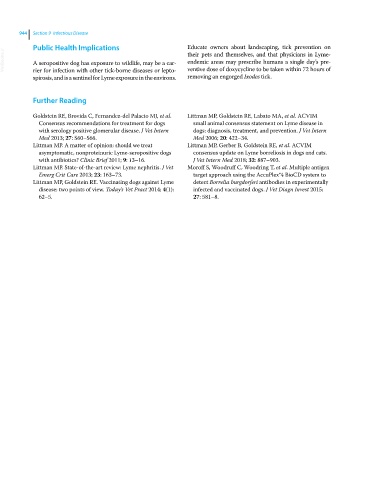Page 1006 - Clinical Small Animal Internal Medicine
P. 1006
944 Section 9 Infectious Disease
Public Health Implications Educate owners about landscaping, tick prevention on
VetBooks.ir A seropositive dog has exposure to wildlife, may be a car their pets and themselves, and that physicians in Lyme‐
endemic areas may prescribe humans a single day’s pre
ventive dose of doxycycline to be taken within 72 hours of
rier for infection with other tick‐borne diseases or lepto
spirosis, and is a sentinel for Lyme exposure in the environs. removing an engorged Ixodes tick.
Further Reading
Goldstein RE, Brovida C, Fernandez‐del Palacio MJ, et al. Littman MP, Goldstein RE, Labato MA, et al. ACVIM
Consensus recommendations for treatment for dogs small animal consensus statement on Lyme disease in
with serology positive glomerular disease. J Vet Intern dogs: diagnosis, treatment, and prevention. J Vet Intern
Med 2013; 27: S60–S66. Med 2006; 20: 422–34.
Littman MP. A matter of opinion: should we treat Littman MP, Gerber B, Goldstein RE, et al. ACVIM
asymptomatic, nonproteinuric Lyme‐seropositive dogs consensus update on Lyme borreliosis in dogs and cats.
with antibiotics? Clinic Brief 2011; 9: 13–16. J Vet Intern Med 2018; 32: 887–903.
Littman MP. State‐of‐the‐art review: Lyme nephritis. J Vet Moroff S, Woodruff C, Woodring T, et al. Multiple antigen
Emerg Crit Care 2013; 23: 163–73. target approach using the AccuPlex®4 BioCD system to
Littman MP, Goldstein RE. Vaccinating dogs against Lyme detect Borrelia burgdorferi antibodies in experimentally
disease: two points of view. Today’s Vet Pract 2014; 4(1): infected and vaccinated dogs. J Vet Diagn Invest 2015;
62–5. 27: 581–8.

